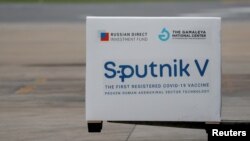South Africa's drug regulator has rejected Russian's Sputnik V vaccine against COVID-19, citing safety concerns that the manufacturer wasn't able to address.
The South African Health Products Regulatory Authority (SAHPRA) said in a statement that the request for Sputnik V to be authorized could “not be approved at this time.”
The statement on October 18 referred to past failed HIV vaccines that used a technology similar to that used to produce Sputnik V. But the review process continues, the regulator said, adding that it is still open to receiving further safety data from the Russian manufacturer.
Peer-reviewed results of a study published earlier this year in the medical journal The Lancet showed Sputnik V to be safe and 91.6 percent effective in preventing people from becoming severely ill with COVID-19. The shot has been given the green light in more than 70 countries, and to date no significant safety problems have been identified.
Sputnik V uses two types of harmless viruses known as adenoviruses to carry the spike protein into the body, which then primes the immune system to produce antibodies against COVID-19. SAHPRA said concerns have been raised about the safety of Adenovirus Type 5, the specific harmless virus used in one of the Sputnik V doses. The other dose contains Adenovirus Type 26, which is also used by Johnson & Johnson.
South African officials pointed to two failed research studies testing an HIV vaccine that also uses Adenovirus Type 5, which found men who were vaccinated had a higher risk of being infected with HIV.
The regulators said they had asked the Russian makers of Sputnik V to provide data proving the vaccine's safety in a country with high rates of HIV but that "the applicant was not able to adequately address (their) request."
The Gamaleya Center, Sputnik V's manufacturer, called the concerns about the vaccine “completely unfounded.” It said speculation about the link between Adenovirus Type 5 and HIV transmission in high-risk populations was based on “small-scale inconclusive studies among volunteers with highly probable risky behavior.”











